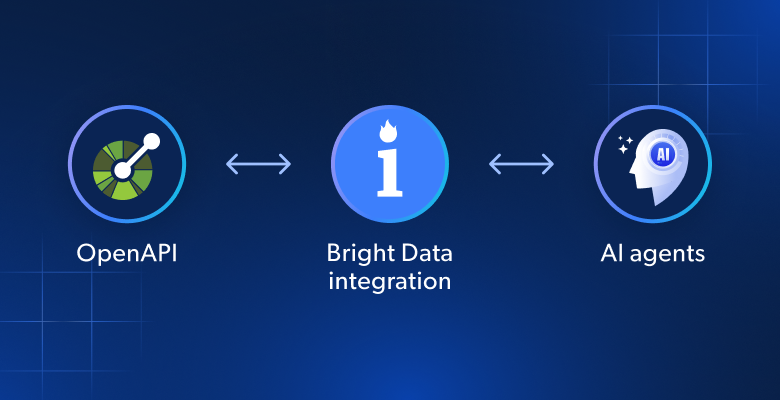本教程将介绍以下内容:
现在就来一探究竟吧!
Python 代理服务器是什么?
Python 代理服务器是一种 Python 应用程序,可充当客户端和互联网之间的中间服务器。该服务器可拦截来自客户端的请求,将这些请求转发到目标服务器,然后将目标服务器的响应发送回客户端,从而向目标服务器掩盖客户端的身份。
欢迎阅读本文,深入了解代理服务器的概念及其工作原理。
用户可以利用 Python 的套接字编程功能轻松实现基本的代理服务器,进而检查、修改或重定向网络流量。在网页抓取方面,代理服务器非常适合缓存、提高性能和增强安全性。
如何在 Python 中实现 HTTP 代理服务器
按照以下步骤操作,了解如何构建 Python 代理服务器脚本。
第 1 步:初始化 Python 项目
在开始之前,请确保计算机上已安装 Python 3 或以上版本。如果未安装,请下载安装程序并运行,按照安装向导进行操作即可。
接下来,使用以下命令创建名为“python-http-proxy-server”的文件夹,然后在其中初始化 Python 项目并创建虚拟环境:
mkdir python-http-proxy-server
cd python-http-proxy-server
python -m venv env在 Python IDE 中打开名为“python-http-proxy-server”的文件夹,然后创建一个名为“proxy_server.py”的空文件。
太棒了!您已完成在 Python 中构建 HTTP 代理服务器的初始设置。
第 2 步:初始化传入套接字
首先,您需要创建一个 Web 套接字服务器来接受传入请求。如果不熟悉这一概念,可以这样理解:套接字是一种低级别的编程抽象,可在客户端和服务器之间实现双向数据流。在 Web 服务器上下文中,服务器套接字可用于监听来自客户端的传入连接。
您可以使用以下命令在 Python 中创建基于套接字的 Web 服务器:
port = 8888# bind the proxy server to a specific address and portserver = socket.socket(socket.AF_INET, socket.SOCK_STREAM)
# accept up to 10 simultaneous connectionsserver.bind(('127.0.0.1', port))server.listen(10)这可以初始化传入的套接字服务器,并将其绑定到本地地址 http://127.0.0.1:8888,然后通过 listen() 方法确保服务器能够接受连接。
注意:您可以随意更改 Web 代理监听的端口号。您也可以修改脚本以从命令行读取该信息,从而最大限度地提高灵活性。
socket 是 Python 标准库中的一个模块,因此,您需要在脚本顶部添加以下导入语句:
import socket要监控 Python 代理服务器是否已按要求启动,请记录以下消息:
print(f"Proxy server listening on port {port}...")第 3 步:接受客户端请求
客户端连接到代理服务器时,需要创建一个新的套接字来处理与该特定客户端的通信。以下是在 Python 中实现此操作的方法:
# listen for incoming requests
while True:
client_socket, addr = server.accept()
print(f"Accepted connection from {addr[0]}:{addr[1]}")
# create a thread to handle the client request
client_handler = threading.Thread(target=handle_client_request, args=(client_socket,))
client_handler.start()要同时处理多个客户端请求,应使用如上所示的多线程。千万别忘记从 Python 标准库中导入 threading 模块:
import threading如您所见,代理服务器可通过自定义 handle_client_request() 函数处理传入请求。有关该函数的定义,详见接下来的步骤。
第 4 步:处理传入请求
创建客户端套接字后,可将其用于以下操作:
- 读取传入请求的数据。
- 从该数据中提取目标服务器的主机和端口。
- 将客户端请求转发到目标服务器。
- 获取响应并将其转发给原始客户端。
本节重点关注前两个步骤。定义 handle_client_request() 函数并用来读取传入请求的数据:
def handle_client_request(client_socket):
print("Received request:n")
# read the data sent by the client in the request
request = b''
client_socket.setblocking(False)
while True:
try:
# receive data from web server
data = client_socket.recv(1024)
request = request + data
# Receive data from the original destination server
print(f"{data.decode('utf-8')}")
except:
break调用 setblocking(False),将客户端套接字设置为非阻塞模式。然后,使用 recv() 读取传入的数据,并将其以字节格式附加到请求中。由于不知道传入请求数据的大小,因此一次只能读取一个区块。本例将一个区块指定为 1024 字节。在非阻塞模式下,如果 recv() 找不到任何数据,这将引发错误异常。因此,except 指令标志着操作的结束。
注意记录的消息,以跟踪 Python 代理服务器正在执行的操作。
检索传入请求后,您需要从中提取目标服务器的主机和端口:
host, port = extract_host_port_from_request(request)
In particular, this is what the extract_host_port_from_request() function looks like:
def extract_host_port_from_request(request):
# get the value after the "Host:" string
host_string_start = request.find(b'Host: ') + len(b'Host: ')
host_string_end = request.find(b'rn', host_string_start)
host_string = request[host_string_start:host_string_end].decode('utf-8')
webserver_pos = host_string.find("/")
if webserver_pos == -1:
webserver_pos = len(host_string)
# if there is a specific port
port_pos = host_string.find(":")
# no port specified
if port_pos == -1 or webserver_pos < port_pos:
# default port
port = 80
host = host_string[:webserver_pos]
else:
# extract the specific port from the host string
port = int((host_string[(port_pos + 1):])[:webserver_pos - port_pos - 1])
host = host_string[:port_pos]
return host, port
To better understand what it does, consider the example below. This is what the encoded string of an incoming request usually contains:
GET http://example.com/your-page HTTP/1.1
Host: example.com
User-Agent: curl/8.4.0
Accept: */*
Proxy-Connection: Keep-Aliveextract_host_port_from_request() 可用于从“Host:”字段中提取 Web 服务器的主机和端口。本例中,主机是 example.com,端口是 80(因为尚未指定特定端口)。
第 5 步:转发客户端请求并处理响应
获得目标主机和端口后,现在您需要将客户端请求转发到目标服务器。在 handle_client_request() 中,创建新的 Web 套接字并用来将原始请求发送到目标服务器:
# create a socket to connect to the original destination server
destination_socket = socket.socket(socket.AF_INET, socket.SOCK_STREAM)
# connect to the destination server
destination_socket.connect((host, port))
# send the original request
destination_socket.sendall(request)
Then, get ready to receive the server response and propagate it to the original client:
# read the data received from the server
# once chunk at a time and send it to the client
print("Received response:n")
while True:
# receive data from web server
data = destination_socket.recv(1024)
# Receive data from the original destination server
print(f"{data.decode('utf-8')}")
# no more data to send
if len(data) > 0:
# send back to the client
client_socket.sendall(data)
else:
break同样,由于不知道响应的大小,一次只能处理一个区块。数据为空时,没有更多数据可供接收,您可以终止操作。
千万别忘记关闭您在函数中定义的两个套接字:
# close the sockets
destination_socket.close()
client_socket.close()太棒了!您已成功在 Python 中创建 HTTP 代理服务器。接下来该查看全部代码,启动并验证其是否按预期运行!
第 6 步:整合所有代码
Python 代理服务器脚本的最终代码如下所示:
import socket
import threading
def handle_client_request(client_socket):
print("Received request:n")
# read the data sent by the client in the request
request = b''
client_socket.setblocking(False)
while True:
try:
# receive data from web server
data = client_socket.recv(1024)
request = request + data
# Receive data from the original destination server
print(f"{data.decode('utf-8')}")
except:
break
# extract the webserver's host and port from the request
host, port = extract_host_port_from_request(request)
# create a socket to connect to the original destination server
destination_socket = socket.socket(socket.AF_INET, socket.SOCK_STREAM)
# connect to the destination server
destination_socket.connect((host, port))
# send the original request
destination_socket.sendall(request)
# read the data received from the server
# once chunk at a time and send it to the client
print("Received response:n")
while True:
# receive data from web server
data = destination_socket.recv(1024)
# Receive data from the original destination server
print(f"{data.decode('utf-8')}")
# no more data to send
if len(data) > 0:
# send back to the client
client_socket.sendall(data)
else:
break
# close the sockets
destination_socket.close()
client_socket.close()
def extract_host_port_from_request(request):
# get the value after the "Host:" string
host_string_start = request.find(b'Host: ') + len(b'Host: ')
host_string_end = request.find(b'rn', host_string_start)
host_string = request[host_string_start:host_string_end].decode('utf-8')
webserver_pos = host_string.find("/")
if webserver_pos == -1:
webserver_pos = len(host_string)
# if there is a specific port
port_pos = host_string.find(":")
# no port specified
if port_pos == -1 or webserver_pos < port_pos:
# default port
port = 80
host = host_string[:webserver_pos]
else:
# extract the specific port from the host string
port = int((host_string[(port_pos + 1):])[:webserver_pos - port_pos - 1])
host = host_string[:port_pos]
return host, port
def start_proxy_server():
port = 8888
# bind the proxy server to a specific address and port
server = socket.socket(socket.AF_INET, socket.SOCK_STREAM)
server.bind(('127.0.0.1', port))
# accept up to 10 simultaneous connections
server.listen(10)
print(f"Proxy server listening on port {port}...")
# listen for incoming requests
while True:
client_socket, addr = server.accept()
print(f"Accepted connection from {addr[0]}:{addr[1]}")
# create a thread to handle the client request
client_handler = threading.Thread(target=handle_client_request, args=(client_socket,))
client_handler.start()
if __name__ == "__main__":
start_proxy_server()
Launch it with this command:
python proxy_server.py
您应该会在终端看到以下消息:
Proxy server listening on port 8888...要确保服务器正常运行,请使用 cURL 执行代理请求。欢迎阅读我们的指南,详细了解如何将 cURL 和代理一起使用。
打开新终端并运行以下命令:
curl --proxy "http://127.0.0.1:8888" "http://httpbin.org/ip"这将通过代理服务器 http://127.0.0.1:8888 向目标服务器 http://httpbin.org/ip 发出 GET 请求。
响应结果如下:
{
"origin": "45.12.80.183"
}响应结果中显示的是代理服务器的 IP。为什么呢?这是因为在 HTTPBin 项目中,/ip 端点会返回发出请求的 IP。如果您在本地运行服务器,则“origin”字段将对应您的 IP。
注意:此处构建的 Python 代理服务器仅适用于 HTTP 目标。如需扩展以处理 HTTPS 连接,操作相当棘手。
接下来,浏览代理服务器 Python 应用程序编写的日志。日志应包含以下内容:
Received request:
GET http://httpbin.org/ip HTTP/1.1
Host: httpbin.org
User-Agent: curl/8.4.0
Accept: */*
Proxy-Connection: Keep-Alive
Received response:
HTTP/1.1 200 OK
Date: Thu, 14 Dec 2023 14:02:08 GMT
Content-Type: application/json
Content-Length: 31
Connection: keep-alive
Server: gunicorn/19.9.0
Access-Control-Allow-Origin: *
Access-Control-Allow-Credentials: true
{
"origin": "45.12.80.183"
}这表明代理服务器接收的请求采用 HTTP 协议指定的格式。代理服务器会将请求转发到目标服务器,记录响应数据,然后将响应发送回客户端。我们为什么确信这一点?这是因为响应结果中“origin”字段显示的 IP 地址与代理服务器的 IP 地址相同。
恭喜!您刚刚学会了如何在 Python 中构建 HTTP 代理服务器!
使用自定义 Python 代理服务器的优缺点
现在您已了解如何在 Python 中实现代理服务器,接下来就该了解这种方法的优点和局限性了。
优点:
- 完全控制:使用类似这样的自定义 Python 脚本有助于完全控制代理服务器的行为。不会有任何可疑活动,也不会泄露数据!
- 自定义:代理服务器可以扩展,以添加日志记录和缓存请求等实用功能,进而提高性能。
缺点:
- 基础设施成本高昂:设置代理服务器架构并不容易,在硬件或 VPS 服务方面需要花费大量资金。
- 难以维护:您需要负责维护代理架构,尤其是确保其可扩展性和可用性。只有经验丰富的系统管理员才能胜任这项任务。
- 不可靠:此解决方案的主要问题在于代理服务器的出口 IP 永远不会改变。因此,反机器人技术能够封锁该 IP 并阻止服务器访问所需的请求。换言之,代理最终将停止工作。
这些局限性和缺点使得在生产场景中使用自定义 Python 代理服务器变得不切实际。有何解决方案?像 Bright Data 这样可靠的代理提供商可助您解决上述问题!您只需创建账户,验证身份,即可获取免费代理,您可以在自己喜爱的编程语言中使用代理,例如在 Python 脚本中使用 requests 库集成代理。
我们庞大的代理网络涵盖全球数百万个快速、可靠、安全的代理服务器。敬请了解为什么我们是最出色的代理服务器提供商。
结语
本指南介绍了代理服务器的概念及其在 Python 中的工作原理。具体而言,您学会了如何使用 Web 套接字从头开始构建代理服务器。您现已成为 Python 代理专家。这种方法的主要问题在于代理服务器的静态出口 IP 最终会被封锁。Bright Data 的轮换代理有助于避免这种情况!
Bright Data 掌控着全球最出色的代理服务器,为财富 500 强企业和 20,000 多家客户提供服务。其代理网络涵盖不同类型的代理:
- 数据中心代理 — 超过 770,000 个数据中心 IP。
- 住宅代理 — 超过 7,200 万个住宅 IP,覆盖 195 个以上的国家/地区。
- ISP 代理 — 超过 700,000 个 ISP IP。
- 移动代理 — 超过 700 万个移动 IP。
Bright Data 具有可靠、快速的全球代理网络,这也是许多网页抓取服务的基础,可帮助这些服务轻松检索各种网站的数据。
支持支付宝等多种支付方式






